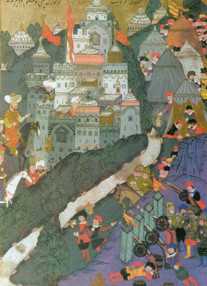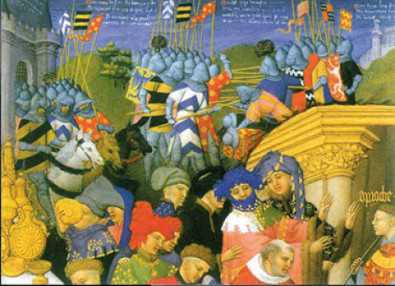The Battle of Nicopolis – 28 September 1396
Szöveg: hungariandefence.com | 2011. szeptember 28. 6:01The crucial battle of Nicopolis was fought between the Ottoman Turks and the Crusaders’ army 615 years ago, on 28th September 1396. We commemorate the historic event by excerpting from the book “For the Homeland Unto Death – 1100 Years” published by Zrínyi Média, which is available in our Digital Library.
After the death of Louis the Great without
a male heir, the throne passed to Mary.
The Queen Mother and the Horváti family,
who wielded considerable power in the south,
each supported a different claimant, but it was
ultimately Mary’s betrothed, subsequently her
husband, Sigismund of Luxemburg, who was
crowned king. This of course did not mean
he acquired supremacy over the kingdom.
To consolidate his position, he took on as
allies the Garai–Cilli–Stibor league of barons,
against other such leagues, but during his
reign he relied on the Rozgonyi–Pálóczi–
Hédervári families.

over the barons was the weakening of the
system of royal castle estates, and thus the
weakening of the country’s military potential.
He had to take account of the rising military
strength of Poland, Bohemia and Venice. The
greatest threat came from the Turkish Empire,
which endangered the very existence of the
kingdom, and not just the southern counties.
In 1397, the Diet created the institution of
telekkatonaság (militia portalis). This required
the equipping of 5 mounted archers for
every 100 tenant peasant plots in a defensive
war. This, however, meant that the soldiers
were effectively peasants, and were difficult
to mobilise. The barons were increasingly
less willing to participate in defence of the
country’s borders. The 1439 Diet decided that
mercenaries should be employed for border
defence. The institution of military barons
was designed to create independence from
the leagues of barons. In exchange for part of
the royal revenues, they were obliged to raise
heavy cavalry.
The measures taken in defence of the country
indicate Sigismund’s mastery of kingship. He
is also associated with a major diplomatic
accomplishment in being the organiser of the
last European crusade.
In 1394, Sultan Bayezid ejected Prince Mircea
of Wallachia and installed the puppet Vlad in
his place. Mircea fled to Hungary and asked
Sigismund’s help. The next year, Sigismund
personally led a campaign to Wallachia, defeated
the Turkish-leaning voivode and helped Mircea
the Elder to regain his throne. The Hungarian
armies reached the Danube and recaptured Little
Nicopolis from the Turks. The military position
now made it possible to force the Ottomans back,
but the Kingdom of Hungary did not have the
military strength to do so on its own, and he called
upon the support of cavalry from throughout
Europe. Sigismund approached the European
powers via the talented diplomat Miklós of
Kanizsa, who found the most receptive ears in
France. A contingent of nearly 1000 armoured
knights set off for Hungary under the command
of Count John of Nevers, heir to the throne of
Burgundy.
In summer 1396, the German Knights and
knights of the Johannites, as well as knights from
England, Poland, Styria, Germany and Bohemia
were assembled in the royal camp and waiting to
set off on what they were confident would be a
successful campaign. “If the sky should fall, we
will hold it up with the tip of our lances!" was
the knights’ watchword. The Crusaders set off
on their campaign in two columns. One column
united with the Transylvania army in the Olt
valley, and the other, led by the King, marched
beside the Danube to Nicopolis, one of the
main bridgeheads for Ottoman armies into the
Balkans.

and a large number of soldiers. Without suitable
siege engines, the Christian army attempted to
starve the defenders out. The relief army led
by Sultan Bayezid approached the town on 24
September. A council of war sat in the evening
to draw up a plan of attack for the next day.
Sigismund and his commanders were familiar
with the Ottoman tactics of initially deploying the
light cavalry, who then retreated to the solid body
of the well dug-in infantry. This had the function
of breaking the momentum of the enemy charge
and preparing the way for the counter-attack
by the heavier cavalry. This was the basis of
the Hungarians’ proposed order of battle. The
Hungarian cavalry would have started the attack,
preparing the field for a charge by the allied heavy
cavalry. The French demurred, insisting that
they attack in the front rank, and that the other
groupings take part only in the development of
the charge. Despite Sigismund’s every effort, no
consensus could be reached. On the morning
of 25 September, the Hungarian King went in
person into the French camp and attempted
to persuade the commanders to change their
view, again without success. He also perceived
that the French contingent had effectively
decided to operate on its own. They prepared
for battle without heed for the other forces. The
subsequent course of events suggests they must
have had their own plan of attack, based on false
knowledge they had acquired about the Turks.
They planned to break up the Ottoman cavalry
in a sweeping charge, dismount, and engage the
infantry on foot. The problem was not so much
with the French commanders’ excessive selfconfidence
so much as their failure to conduct
the battle together with their allies. They were
trained fighters, with excellent weaponry and
armour, but their inability to cooperate with allies
in battle had been proved by the 1346 Battle of
Crécy, where the French knights ran down their
own Genovese crossbowmen during the charge.
It was to be feared that the Hungarian and
Wallachian cavalry fighting in the van at Nicopolis
would be in for a similar fate, because in the
heat of the battle, it would have been difficult
for the French to distinguish foreign-speaking
soldiers from the Turks. Upon returning to
camp, the King immediately issued the order to
take up battle order. In the meantime, the French
moved out of their camp in long rows, taking
up a formation in the field in front along a long
line. As soon as they had formed up, they started
advancing against the Turkish cavalry which had
just appeared at the edge of the field in front of
them.
The Hungarian and allied troops were not
yet ready to charge. István Laczkfy commanded
the right wing, King Sigismund and Herman of
Cilli the centre, and Voivode Mircse of Wallachia
the left wing. The right wing consisted purely
of Hungarians, the centre of Hungarians and
Germans (mainly Bavarians and Styrians), the
former commanded by Count Herman of Cilli,
the latter by the Kanizsais – János, Rozgonyi
and Forgách Maróthi. The left wing contained
purely Wallachians. Behind them was a reserve
of Bohemians, Poles, Serbs and Bosnians led
by Miklós Garai, Ban of Croatia. The closed
charge of the French swept away the Turkish
light cavalry standing in the front. Pursuing the
fugitives, they reached the camp of the Ottoman
infantry, surrounded by an obstacle of pointed
stakes driven into the ground at an angle.
French dismounted, arranged themselves into a
tight mass, and started to charge. The Janissaries’
arrows must have made little impression on their
armour, and they pressed forward unhindered.
The Turkish infantry soon started to retreat.
Until that moment, the hope of victory was on
the Christian side. But the dismounted knights
were not capable of pursuing the retreating
Turks. They would have needed the Hungarian
and allied forces that had been left behind.
The
Sultan now deployed the Spahis, who attacked
the French knights’ horses. The shield-bearers
fled towards the camp, as did the horses. In
the meantime, the King gave the command to
advance, but they had not reached the Janissaries’
positions when the mass of riderless French
horses, with the Ottoman cavalry behind, rushed
towards them. This slowed down the advance and
disrupted the battle order. Through determined
struggle, however, the Ottoman cavalry was
pushed back and the troops led by the King
reached the remnants of the French knights
fighting on foot. A bloody hand-to-hand combat
ensued between the cavalry, in which Sigismund’s
army began to make headway. The battleground,
however, harboured an unpleasant surprise. A
substantial troop of Serbs was hidden in one of
the alluvial valleys, and made a surprise attack on
the flank of the Christian army. The momentary
confusion allowed the remnants of the Ottoman
army to regroup and launch a counter-attack.
Control slipped from Sigismund’s hands, and
his multinational army took flight in whatever
direction they could.
The defeat was definite proof that the main
task of the following decades would be to halt
the Ottoman expansion. The failure of the
campaign pointed up the importance of strong
defence, which Sigismund sought to provide by
a set of buffer states along the southern borders,
and when this failed, a line of defensive forts.
Around 1435, he directed every available source
of revenue in the south of the country towards
defence of the threatened border, and put the
entire line of border fortresses between Szörény
and the Adriatic under centralised command.

in 1410. It was then he called the Council of
Constance (1414–1418), to which he succeeded
in bringing all of Europe to the negotiating table.
The Council’s main task was to address the church
schism which had been threatening since 1378.
There were three popes at the time, all of which
had a country which swore allegiance to him
alone. Sigismund succeeded in making all three
popes resign, and to have one, Martin V, elected
in their place. The second issue was church
reform, because the authority of the church at
that period had fallen to an all-time low. After the
election of Pope, however, the reforms came off
the agenda. The Council of Constance examined
the Czech reformer John Huss, who Sigismund
at first supported, but under pressure from the
bishops, condemned to death.
In 1419, after
the death of his brother Wenceslas, Sigismund
put forward his rightful claim to the throne of
Bohemia. His actions in Constance, however,
had set him against the Czechs, and the 17-year
Hussite Wars began, against which a crusade was
proclaimed. In 1431, he succeeded in dividing
the rebels. The Calixtines changed to his side,
and with their help, he struck the decisive blow
against the Taborites in 1434. It was towards
the end of the Hussite Wars that he scored his
greatest success: in 1433 the Pope appointed him
Holy Roman Emperor.
The Sigismund Era was
a turning point in Hungarian military affairs. The
burgeoning Ottoman Empire not only threatened
the southern border lands, it directly endangered
the kingdom itself, and in subsequent decades,
defence against Turkish conquest became the
prime task of the Hungarian military.